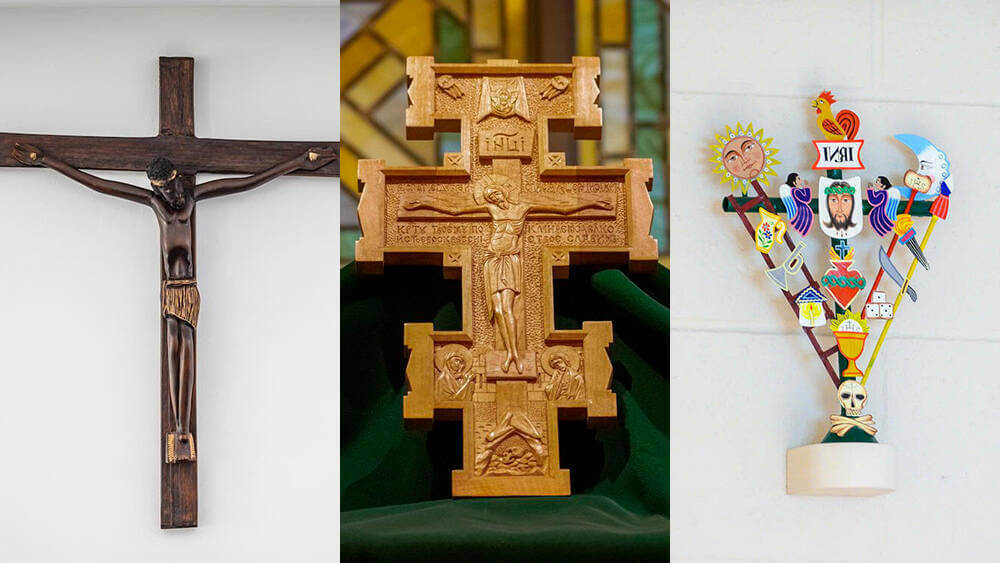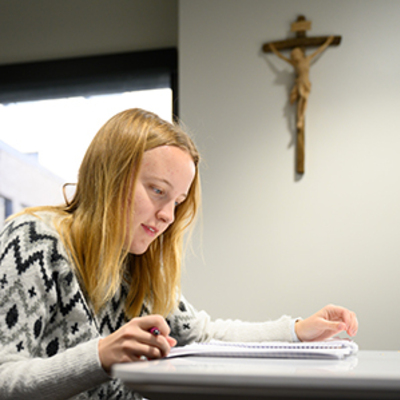Global works of art from Notre Dame Crucifix Initiative to be displayed at The History Museum

The image of the crucifix in sacred art holds the ability to convey both the humanity and divinity — the beauty and the suffering — of Christ.
For Mark Roche, founder of the University of Notre Dame’s Crucifix Initiative, it also represents the universalism and diversity of the Catholic experience.
Launched in 2019, the initiative seeks to highlight the globalism of Catholicism — and to represent the diversity and internationalism of the University and its community — by building and displaying a collection of crucifixes from around the world.
Selected works of art from the Crucifix Initiative will be on view in an exhibit starting Thursday (Aug. 10) at The History Museum in South Bend, Indiana. Developed by Notre Dame International, the exhibit chronicles the history of international education at the University of Notre Dame, from its founding to today, with attention to the theme “Bringing the world to Notre Dame and Notre Dame to the world.”

To date, the Crucifix Initiative’s growing collection, displayed in classrooms and buildings across campus, includes nearly 40 representations of the crucifix from six continents and more than 20 countries.
As more and more students from around the world and from diverse American backgrounds come to Notre Dame, University leaders continue to look for additional ways to foster a welcoming environment, said Roche, the Rev. Edmund P. Joyce, C.S.C., Professor of German Language and Literature and a concurrent professor of philosophy. Displaying these works of art not only contributes to that environment but also offers an opportunity for reciprocal learning, he said.
“The diversity of styles and emphases that we find in crucifixes from around the world are extraordinary,” said Roche, a former dean of Notre Dame’s College of Arts and Letters and chair of the committee leading the Crucifix Initiative. “We want to cultivate and embrace that diversity here on campus and, through these connections, express our solidarity with artists and regions around the world.”
Not only are the crucifixes wide-ranging, the initiative to bring crucifixes to Notre Dame involves one of the broadest-based committees at the University, bringing together the expertise and capacities of faculty, staff, students and members of the Congregation of Holy Cross.
Representations of the crucifix on display at The History Museum will include:
- A brightly colored “Road Cross” from Huancayo, Peru, designed to protect travelers on their journeys, adorned with symbols including a rooster, a ladder, the sun and the moon, along with the face of Christ.
- A simple and slender wooden crucifix, crafted by local artists in the port city of Luanda, Angola, and bringing together Central African and European artistic genres.
-
A contemporary Chinese painting, “Crucifixion on the Red Cross,” donated by renowned artist Dao Zi and featuring bold colors, sweeping lines and exaggerated proportions of the holy nails.
-
A detailed pearwood carving titled “Life-Giving Cross” with images of Mary and John alongside Jesus that follows the Ukrainian Greek Catholic tradition of Fr. Yuvenaly Mokrytsky, a hieromonk whose religious order was brutally suppressed by the Soviet Union.

The initiative is working to secure additional works of art with support from Notre Dame faculty, staff, students and alumni clubs worldwide. Its most recent acquisitions include a Japanese crucifix in the style of a butsudan — a small wooden box with cabinet doors that enclosed a painting or statue of Buddha — commonly used by underground Catholics at a time when Catholicism was suppressed, and a forthcoming piece from Ireland made from a bog oak tree that has been carbon-dated to 5,600 years ago. The committee is also working with First Nations artists on several pieces.
A contest will also be announced at the beginning of the academic year for a student-designed and -crafted crucifix to be added to the collection, and plans are underway for a self-guided tour of the crucifixes on campus during the Lenten season.
The initiative, Roche said, helps to further Notre Dame’s Catholic mission, as well as the University’s goals of prioritizing diversity and inclusion, elevating the arts and promoting student research and creative work.
“The arts are central to a Catholic university,” Roche said. “In the history of the arts to the early modern period, every artwork was created for the greater glory of God, and the sacramental vision of Catholicism is the idea that the divine is made visible, manifest in this world. There is a special connection between images of the crucifix, in particular, and both the universalism and diversity of the Catholic experience worldwide.”
Latest International
- University of Notre Dame joins the Global Coalition of Ukrainian StudiesThe University of Notre Dame has joined the Global Coalition of Ukrainian Studies after signing a memorandum of cooperation, formalized Sept. 24, at the Ukrainian Institute of America in New York City. Notre Dame joined four other American institutions that were also publicly welcomed to the coalition at this event: Arizona State University, Columbia University, Manor College and the Shevchenko Scientific Society.
- Statement from University President Rev. Robert A. Dowd, C.S.C., on the anniversary of the atomic bombing of HiroshimaToday, on the anniversary of the bombing of Hiroshima, Father Dowd offered remarks at the Elisabeth University of Music as a guest of its president, Yuji Kawano, and Bishop Alexis Mitsuru Shirahama of Hiroshima. Father Dowd focused on the role that universities can play in addressing the current nuclear predicament and the wider challenges of peace in today’s world.
- Vatican honors Martin and Carmel Naughton with papal awardThe late Pope Francis, in one of his last acts, conferred the honour of the Order of Saint Gregory the Great upon Carmel and Martin Naughton, Trustee Emeritus of the University of Notre Dame. The papal honor is in recognition of the Naughtons’ outstanding philanthropy in the areas of education and the arts, particularly in the provision of philanthropic support and scholarships to Catholic education at the University of Notre Dame and Kylemore Abbey, and in their transformative contributions to higher education in Ireland.
- Prioritizing prenatal care may decrease low birth weight outcomes in The Gambia, Notre Dame research findsA new study co-authored by University of Notre Dame researchers highlights the importance of prenatal care for improving the health of mothers and newborns, providing evidence that can inform policy.
- Navigating the waters of peace: Researchers address challenges, opportunities in implementation of Colombia's Peace AgreementNearly half of the commitments outlined in Colombia's historic peace accord face significant challenges and may not happen in time unless policymakers make several key interventions, warns a new report from Notre Dame's Peace Accords Matrix. The report offers a blueprint to salvage an accord that has lagged behind its implementation deadlines, putting its legacy at risk. It highlights timely fixes that can strengthen the agreement.
- Partial peace deals may facilitate comprehensive accords, offering roadmap for policymakers, practitionersPartial peace agreements — deals that address targeted issues on the way to larger comprehensive accords — could provide a blueprint for peacebuilding policymakers and practitioners, according to new University of Notre Dame research.













